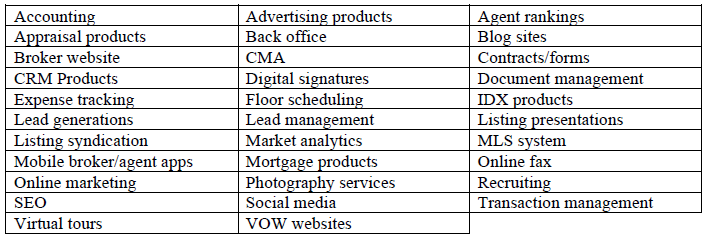You are viewing our site as a Broker, Switch Your View:
Agent | Broker Reset Filters to Default Back to ListSifting Through the Maze of Broker Technology
November 09 2010
 Brokers, large and small, face significant challenges they did not face 20 years ago. Profit margins have eroded and control over their independent contractors has been minimized. The consumer has taken on a much more vocal role in the process and is forcing transparency and responsiveness never before experienced. Some of these challenges are related to technology and the advance of the Internet while others are cultural challenges that have come about through the changing broker/agent relationship. WAV Group’s new white paper explores the issues behind the broker’s challenge to gain better control and visibility into their companies while re-establishing a new value proposition for their agents!
Brokers, large and small, face significant challenges they did not face 20 years ago. Profit margins have eroded and control over their independent contractors has been minimized. The consumer has taken on a much more vocal role in the process and is forcing transparency and responsiveness never before experienced. Some of these challenges are related to technology and the advance of the Internet while others are cultural challenges that have come about through the changing broker/agent relationship. WAV Group’s new white paper explores the issues behind the broker’s challenge to gain better control and visibility into their companies while re-establishing a new value proposition for their agents!
While part one of this five part series focused on understanding how brokers got into the technological mess they find themselves today. Part 2 of this 5 part series, opens the discussion for how brokers can sift through the maze of technology that currently exists in the industry.
Brokers are amazing people. They are leaders, motivators, trainers and counselors.
As part of their business they also need to be able to select and implement technology to serve their needs and the needs of their agents. As the Internet has unfolded and more and more processes have become automated, brokers have been required to develop totally new skill sets, or hire them, to address these technology needs. There are many areas within the broker’s world that require automation. Here is just a partial list.

Many companies, small to large, have implemented multiple products to address these areas. Implementation has taken place over time and as a result we find that companies have many different products, from many different vendors, addressing each issue individually. This fact, while it is totally understandable, has created a bit of a nightmare in terms of trying to get these products to work together. When you couple the fact that our industry does not really have data standards to help manage this process you realize the problem is quite formidable.
Our Industry is Spineless
The broker technology industry does not have a “backbone” or infrastructure that allows for the unique products to work together seamlessly. While I can plug my Sony DVD into my Toshiba HDTV and have it work perfectly and I can even manage both with a single remote control, I can’t have my broker accounting and membership system talk to my lead generation system in any meaningful way if they come from different vendors.
Would you build a house room by room using different contractors for each space with each contractor working from a design that they created? What if each contractor was given plans that provided general requirements they had to adhere to like how many doors, closets, windows, size, etc., but they didn’t specify style. What if it included requirements for plumbing and electricity but it didn’t include specific requirements on pipe size or type or the amperage requirements on the electrical system? Can you imagine the house you would end up with? You might have a Colonial style entrance transitioning to a Tudor section that was attached to a ultra modern wing…you get the idea. Plumbing might go from half inch copper to quarter inch plastic from room to room and from 20 amp service to 15 amp service from section to section.
Would the house work? Yes, things could be connected with the right “special” connectors. It would be dry, have power, water would flow, there would be a space to cook and put furniture, but it would also be lacking some really great things. It would lack a consistent look and feel. It would lack a consistent style and it would require additional contractors to come in to “connect” the sections of different plumbing and wiring. It would not make you feel “comfortable” walking through and based on how different sections were it could be totally confusing. In short, it would be a mess. Basically you would have a house built without a solid infrastructure. The end result would be nothing but the gluing together of different pieces.
In many ways, this is what brokers face today as they face the daunting task of building an automated solution to manage their businesses. They need numerous solutions from accounting and back office systems to contact management and marketing tools to website tools.
Much like the house built by different contractors, what they end up putting together might work but in many cases these processes are far from elegant, lack a consistent look and feel, and are often lacking in their ability to work in an integrated fashion. They weren’t built with a common interface or even a common standard. They might be able to share data at some level but it is very likely that this data sharing will be limited.
People using these different products will also note that the look and feel of each is totally different and each requires a separate learning process. Moving from one to the other will not “feel comfortable”. The result is that in spite of highly computerized processes and automated systems many pieces of the broker’s world are like the house built by different contractors. Parts will still be fairly isolated requiring extensive manual intervention to keep things in sync or they will require “specialty products” to connect them. It is not in most cases an elegant or optimal solution and there may be extra costs involved! If you compare these tools to a body you might say our broker technology body does not have a backbone or infrastructure to manage data throughout, but are rather a bunch of separate, uncoordinated parts!
Lack of Broker Infrastructure in Practice
To illustrate how this lack of infrastructure affects the average real estate office, think for a moment what happens when an agent leaves an office or you have a simple change to a phone number or an email. Here are some of the areas that might need to be touched to make sure your data is updated correctly.
- Office roster
- Accounting system
- Back office/billing system
- MLS system
- Marketing/communication system
- Floor time roster
- Broker website
- Agent website
- 3rd party sites – i.e., Realtor.com, Zillow.com, Trulia.com etc.
- Advertising system
- Email system
- Franchisors
- Real Estate Boards
How is this accomplished today? For the most part it is done manually. The administrator for the office has developed a process and knows all of the things that have to be done to make this change occur. Even so, we have all seen times where agents move offices and their information still shows on the former broker’s site or new agents join a firm and no information can be found. This is just a simple example and just the tip of the iceberg of non-integration.
Lack of Integration – Limits Ability to Track ROI
Integration and problems of infrastructure are not confined to personal information. There are numerous points within a real estate business where it would make perfect sense to share data and have one business module talk to another business module. For example, an office might run a marketing campaign where they implement a new web strategy. This strategy would have an associated cost within the budget and over time the broker will want to see the impact of this plan to their bottom line. Leads may result from the campaign that gets captured over the Internet. Through a separate CRM system these leads may then get moved through the company and over time a certain percentage of them may result in closed business and revenue to the company.
The broker ideally would like to track the number of leads generated, overall web activity resulting from the plan, the number of lead conversions, by agent and overall cost per lead. To do this today, with multiple systems in place from different vendors, would require a great deal of manual intervention. With the right infrastructure or with a product set provided by one vendor, this data ideally can flow from one end of a broker’s business to the other without any manual intervention. The benefits are pretty obvious.
Unfortunately this is not what happens in most real estate offices today. Systems have been put together without a common thread, because one did not always exist. It wasn’t that broker’s made bad technology decisions it is just that they didn’t have any options for a more integrated solution in the past.
Creating “Infrastructure” in the Broker Technology World
Infrastructure is the framework and foundation that allows for any structure, process or system to be created and to work seamlessly with all of its related parts. From buildings to computer systems to legal systems, infrastructure is critical for the entity to work optimally. Infrastructure is the piping that allows information to flow seamlessly within any structure or process. Our industry has pieces of infrastructure, but we lack a cohesive standard that allows all processes within a brokerage to be connected seamlessly when the products are supplied by different vendors.
This is where a large part of the problem lies and also why we are seeing some technology companies begin to address it effectively with broader, more tightly integrated product platforms.
From the smallest office to the mega office many brokers are feeling the impact of using multiple vendor’s products to support their operations. The problem is clear. They don’t integrate. There are lost data and business management opportunities as a result. The following chart shows a partial list of broker products that we pulled from RETechnology.com, a portal that is focused on real estate technology products.

In a perfect world, every single system shown above should be able to share data with each other. In a perfect world, we would enter data once and that data would flow throughout the organization wherever it is needed. Redundant data entry would be eliminated.
This is part two of a five part series called "Broker Technology - An Industry Needing a Backbone." This white paper was written and researched by WAV Group, Inc.
If you would like to see the release of this white paper, please click here.
To learn more about WAV Group, please click here.










